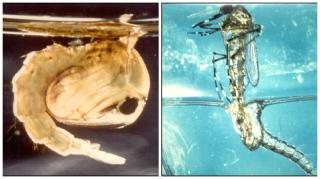Pupae

The mosquito pupae are the final stage before the adult, and like the larvae also lives in the water. It is very active, does not feed, and must come to the surface for air like the larvae. One exception is the pupae of the Cq. perturbans, whose pupae (and larvae) are attached to the roots of underwater plants. Seeing pupae is often considered evidence of poor control, because they rarely spend more than 2 or 3 days in this stage. Like the larvae, this depends on the temperature of the water and other factors.
Mosquito pupae are one of the most active of all insect pupae. Most are lighter than water, their buoyancy due to an air space in the pupae itself. By vigorous movements of it's abdomen, pupae are able to move with remarkable speed, but rise directly to the surface when movement stops.
The pupal stage lasts from 1 day to a few weeks. No species at this time are known to overwinter as pupae. At the ends of this stage, the pupal skin is broken along the dorsal mid-line and the adult works its way out onto the surface of the water. This is another reason the stillness of the water is important. Once free of the pupal skin, the adult rests for a time to dry it's wings, then it's ready to fly away.

